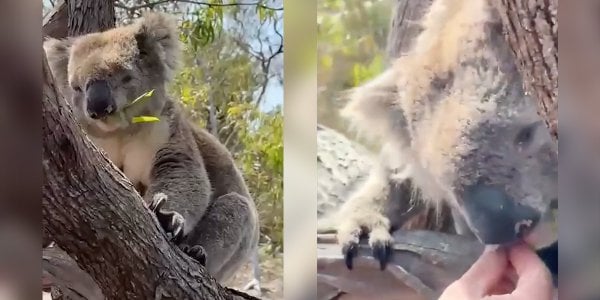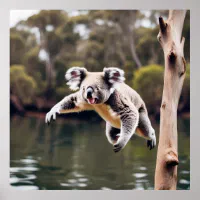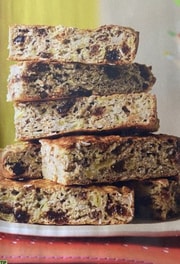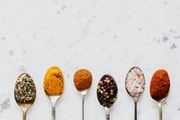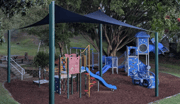Don't make this dangerous mistake with koalas: ‘They’ll open you right up’
By
Seia Ibanez
- Replies 9
Australia is a land of unique and fascinating wildlife, and for many tourists, the opportunity to see a koala in the wild is a dream come true.
However, a recent incident involving a tourist feeding and petting a wild koala has sparked a serious warning from wildlife experts: these adorable marsupials are not as harmless as they seem.
In a video that has since gone viral, a man can be seen on Victoria's popular Raymond Island feeding eucalyptus leaves to a large male koala perched on a low-hanging branch.
The onlookers, seemingly unaware of the potential danger, laugh and cheer as the man interacts with the wild animal.
While the risks associated with feeding crocodiles and dingoes are well-known, many tourists are not aware of the potential dangers posed by Australia's iconic koalas.
Contrary to popular belief, the primary threat is not chlamydia, a sexually transmitted disease prevalent among koalas, but their sharp teeth and claws.
'They may look cute and cuddly, but they have sharp teeth that are like a vice. And the claws are like razor blades—they’ll open you right up,' warns Victorian Koala Rescuer Shelley Robinson.
‘The worst ones are little joeys because their claws are like needles because they haven’t been blunted by climbing.’
‘They don’t mean to hurt you. They’re just nicely holding onto you, and all of a sudden, they’ve cut through the skin just from touching you.’
This is not a tall tale about the mythical 'drop bears'—koala-like creatures with sharp teeth that tour guides often use to scare unsuspecting tourists.
This is a genuine warning about the potential dangers of handling koalas without the necessary expertise.
In 2022, a driver learnt a hard lesson when she tried to rescue a koala on a road but fell over when it tried to scale her leg.
In most Australian states, wildlife volunteers require additional training to care for these animals.
The dangers of interacting with wild koalas extend beyond personal injury.
Human interference can have fatal consequences for these marsupials.
Feeding koalas can disrupt their natural diet, and giving them water directly from a bottle can lead to pneumonia or aspiration.
Furthermore, a koala accepting food from humans or being found low on the ground could indicate ill health.
Robinson, the President of Koalas of Raymond Island, offers clear advice to tourists: 'Don’t feed them, touch them, or pet them. If they’re on the ground, it’s an indicator something is wrong.'
In such cases, it is recommended to contact a local wildlife rescue group, which will provide assistance free of charge.
The man in the video was fortunate that another tourist recognised the potential danger and alerted Robinson and her team at Koalas of Raymond Island.
The koala, named Tobias, was well-known to the group, which has named and cared for many of the island’s marsupial residents.
After noticing a large scratch on Tobias from a recent fight, the team treated him and released him a few days later.
If you see these unique creatures in their natural habitat, remember to respect their space and observe from a distance.
If you'd like to support the conservation efforts, consider donating to organisations like Koalas of Raymond Island.
Several years ago, the Great Koala National Park was built to be a safe haven for the now-threatened koala as its numbers dwindle.
But will this park be enough to save the koala from extinction? Learn more about it here.

Are you aware of this rule of not feeding wild koalas? Let us know in the comments below!
However, a recent incident involving a tourist feeding and petting a wild koala has sparked a serious warning from wildlife experts: these adorable marsupials are not as harmless as they seem.
In a video that has since gone viral, a man can be seen on Victoria's popular Raymond Island feeding eucalyptus leaves to a large male koala perched on a low-hanging branch.
The onlookers, seemingly unaware of the potential danger, laugh and cheer as the man interacts with the wild animal.
While the risks associated with feeding crocodiles and dingoes are well-known, many tourists are not aware of the potential dangers posed by Australia's iconic koalas.
Contrary to popular belief, the primary threat is not chlamydia, a sexually transmitted disease prevalent among koalas, but their sharp teeth and claws.
'They may look cute and cuddly, but they have sharp teeth that are like a vice. And the claws are like razor blades—they’ll open you right up,' warns Victorian Koala Rescuer Shelley Robinson.
‘The worst ones are little joeys because their claws are like needles because they haven’t been blunted by climbing.’
‘They don’t mean to hurt you. They’re just nicely holding onto you, and all of a sudden, they’ve cut through the skin just from touching you.’
This is not a tall tale about the mythical 'drop bears'—koala-like creatures with sharp teeth that tour guides often use to scare unsuspecting tourists.
This is a genuine warning about the potential dangers of handling koalas without the necessary expertise.
In 2022, a driver learnt a hard lesson when she tried to rescue a koala on a road but fell over when it tried to scale her leg.
In most Australian states, wildlife volunteers require additional training to care for these animals.
The dangers of interacting with wild koalas extend beyond personal injury.
Human interference can have fatal consequences for these marsupials.
Feeding koalas can disrupt their natural diet, and giving them water directly from a bottle can lead to pneumonia or aspiration.
Furthermore, a koala accepting food from humans or being found low on the ground could indicate ill health.
Robinson, the President of Koalas of Raymond Island, offers clear advice to tourists: 'Don’t feed them, touch them, or pet them. If they’re on the ground, it’s an indicator something is wrong.'
In such cases, it is recommended to contact a local wildlife rescue group, which will provide assistance free of charge.
The man in the video was fortunate that another tourist recognised the potential danger and alerted Robinson and her team at Koalas of Raymond Island.
The koala, named Tobias, was well-known to the group, which has named and cared for many of the island’s marsupial residents.
After noticing a large scratch on Tobias from a recent fight, the team treated him and released him a few days later.
If you see these unique creatures in their natural habitat, remember to respect their space and observe from a distance.
If you'd like to support the conservation efforts, consider donating to organisations like Koalas of Raymond Island.
Several years ago, the Great Koala National Park was built to be a safe haven for the now-threatened koala as its numbers dwindle.
But will this park be enough to save the koala from extinction? Learn more about it here.
Key Takeaways
- Tourists are warned not to handle wild koalas due to the risks of injury from their sharp teeth and claws.
- Koalas may appear gentle but can be dangerous, and incorrect interaction can harm the animals themselves, such as giving them pneumonia.
- The article includes an account of a man on Raymond Island who had an interaction with a koala that required intervention from local wildlife rescuers.
- Experts advocate for observing koalas from a distance and contacting wildlife groups if a koala seems to be in distress rather than intervening directly.
Last edited:

